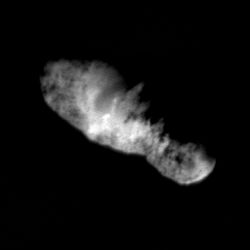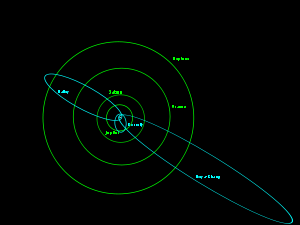- 19P/Borrelly
-
19P/Borrelly  Discovery
DiscoveryDiscovered by Alphonse Borrelly DesignationsAlternate name(s) 1905 II; 1911 VIII; 1918 IV;
1925 VIII; 1932 IV; 1953 IV;
1960 V; 1967 VIII; 1974 VII;
1981 IV; 1987 XXXIII; 1994 XXXEpoch September 8, 2001 (JD 2452160.5) Aphelion 5.83 AU Perihelion 1.35 AU Semi-major axis 3.59 AU Eccentricity 0.624 Orbital period 6.8 a Inclination 30.3° Physical characteristicsDimensions 8×4×4 km[1] Mass 2×1013 kg[2] Mean density 0.3 g/cm³[3] Albedo Albedo: 0.03[4]  The orbits of three periodic comets, 1P/Halley, 19P/Borrelly and 153P/Ikeya-Zhang, set against the orbits of the outer planets.
The orbits of three periodic comets, 1P/Halley, 19P/Borrelly and 153P/Ikeya-Zhang, set against the orbits of the outer planets.
Comet Borrelly or Borrelly's Comet (official designation: 19P/Borrelly) is a periodic comet, which was visited by the spacecraft Deep Space 1 in 2001.
Contents
Discovery
The comet was discovered by Alphonse Borrelly during a routine search for comets at Marseilles, France on December 28, 1904.
Deep Space 1 flyby
On September 21, 2001 the spacecraft Deep Space 1, which was launched to test new equipment in space, performed a flyby of Borrelly. It was steered toward the comet during the extended mission of the craft, and presented an unexpected bonus for the mission scientists. Despite the failure of a system that helped determine its orientation, Deep Space 1 managed to send back to Earth what were, at the time, the best images and other science data from a comet.
References
- ^ Weaver, H. A.; Stern, S.A.; Parker, J. Wm. (2003). "Hubble Space Telescope STIS Observations of Comet 19P/BORRELLY during the Deep Space 1 Encounter". The American Astronomical Society 126 (1): 444–451. Bibcode 2003AJ....126..444W. doi:10.1086/375752. http://www.iop.org/EJ/article/1538-3881/126/1/444/202321.text.html. Retrieved 2008-12-16.
- ^ Using the volume of an ellipsoid of 8x4x4km * a rubble pile density of 0.3 g/cm³ yields a mass (m=d*v) of 2.0E+13 kg.
- ^ D. T. Britt; G. J. Consol-magno SJ; W. J. Merline (2006). "Small Body Density and Porosity: New Data, New Insights". Lunar and Planetary Science XXXVII. http://www.lpi.usra.edu/meetings/lpsc2006/pdf/2214.pdf. Retrieved 2008-12-16.
- ^ Robert Roy Britt (2001-11-29). "Comet Borrelly Puzzle: Darkest Object in the Solar System". Space.com. http://www.space.com/scienceastronomy/solarsystem/borrelly_dark_011129.html. Retrieved 2008-12-16.
External links
Periodic comets (by number) Previous
18D/Perrine-Mrkos19P/Borrelly Next
20D/WestphalCategories:- Comets visited by spacecraft
Wikimedia Foundation. 2010.
